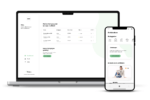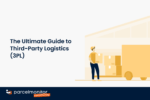If you run a business in Germany, you’ve probably thought about selling abroad. Maybe you’ve had a few international orders come in. Maybe you’re seeing local demand slow down. Or maybe you’re just curious about what’s possible outside your home market. The truth is that cross-border trade in Germany continues to grow. That’s because tools are easier, logistics are smoother, and buyers are not afraid to purchase from different corners of the world. So… why not try selling outside Germany?
Let’s find out more about what cross-border trade in Germany looks like right now, why it matters, and how to get your business ready to expand.
What is cross-border e-commerce?
Cross-border e-commerce means selling products or services to customers in other countries through different online channels. For example, you can run your own shop or sell through platforms like Amazon, Zalando, or Etsy. It can be B2C, B2B, or even peer-to-peer.
Cross-border matters because people are shopping globally more than ever. Shoppers today don’t think twice about ordering from another country if the product, price, and shipping time make sense. They trust international brands, especially when local options fall short or feel overpriced.
Moreover, the barriers are lower than they used to be. Payment tools, translations, and shipping integrations make international selling possible even for small businesses. And inside the EU, things are even smoother thanks to SEPA transfers, shared data rules (GDPR), and simplified VAT reporting through OSS.
In short: cross-border e-commerce is growing fast, and 2025 is a good year to get in.
And if you’re selling online in Germany and still sticking to your home market, you’re probably missing out on real potential.
Cross-border trade in Germany: the 2025 scene
Now let’s take a closer look at how the cross-border trade landscape actually looks in 2025.
Germany’s export-driven economy is facing some challenges. Orders aren’t coming in like they used to. Exports are down again this year – DIHK expects a 2.5% drop. That’s three years in a row. And out of 23,000 companies surveyed, nearly a third said they expect even lower exports in 2025. Only 19% are hopeful for an increase.
What does this mean?
💡 Exports are slowing down, and many companies are already feeling it. If you’re trading internationally, you might need to explore new markets or rethink your strategy to stay on track. If you are just starting with cross-border, you need to get clear on the basics: what to sell, where to sell it, and how to make sure your setup won’t trip you up down the line.
The United States remains Germany’s largest trading partner, with bilateral trade totaling €253 billion in 2024. However, the introduction of new U.S. tariffs has raised concerns among German exporters.
A survey by the DIHK indicates that 70% of internationally active German firms foresee negative impacts from U.S. trade policy. So, if you’re exporting to the U.S., keep a close eye on trade rules. Higher costs or new restrictions could hit your margins or delay shipments, so now’s the time to stay flexible and have a backup plan.
The good news is that despite these challenges, opportunities exist.
Cross-border e-commerce is gaining momentum, with global B2C online trade projected to reach $5.1 trillion by 2030. This means there’s real money on the table if you’re ready to sell beyond Germany. Digital platforms make it easier than ever to reach new markets, and logistics partners are stepping up their game too.
And payments? Also getting easier. Thanks to SEPA, moving money across EU borders doesn’t come with the old-school friction.
So if you’re thinking of going international, this might be the right moment. The world’s changing fast—sticking to local sales could mean missing the bigger picture.
Why going international makes sense for German retailers in 2025?
German products still carry a lot of weight abroad. That “Made in Germany” label means something, especially in categories like home appliances, fashion, auto parts, and eco-friendly goods. Buyers trust the quality and precision.
So while domestic sales are crucial, cross-border trade in Germany is one of the few areas that presents significant opportunities.
The numbers speak for themselves. In 2023, Europe hit €237 billion in cross-border sales. In 2024, the number grew by 16%, reaching €275.6 billion for the B2C cross-border e-commerce market in Europe. Germany was a big part of that, and the momentum is still there.
What’s more, cross-border trade is not reserved only for those retailers who want to sell exclusively on foreign markets. This strategy can be used flexibly.
For example, business owners can choose it to:
- just reach new customers in nearby markets without setting up local shops or warehouses
- spread out risk across different countries. When one market slows, another might stay steady.
And here is another interesting part: digital commerce lets you test new markets with low upfront cost. You don’t need a warehouse in Spain to start selling there, you need the right setup:
- Translated product info
- Clear return policies
- Reliable shipping
- And local payment options.
And you don’t have to build your offerings from scratch. Platforms like Shopify, Stripe, and Amazon take care of most of the heavy lifting.
Germany’s e-commerce is on the rise, despite slowing domestic growth. That tells us something: buyers are still spending, but they’re more selective and more open to shopping across borders.
How to select the right target markets?
One of the first decisions you’ll make when stepping into cross-border e-commerce is: where do I start?
Not all countries are equal. So before launching into the unknown, take a step back and figure out which markets actually make sense for your business.
Start with where demand already exists.
- Look at where your traffic comes from (check your analytics). Are customers from France, Austria, or the Netherlands already browsing your site? That’s a good sign.
- You can also dig into public data: in 2024, France and Spain were among the top e-commerce growth markets in Europe. These countries are also part of the EU, which makes logistics and tax rules much easier to manage.
Next, think about logistics and distance. Cross-border trade in Germany benefits from geography (you’re right in the middle of Europe). That gives you access to dozens of markets with short delivery times.
- Focus on nearby regions first, especially if you’re new to cross-border. Selling to Poland or Austria might be simpler than shipping to Canada.
Language and customer expectations matter, too.
- If your team speaks English, starting with Ireland or the Nordics can be smoother than trying to launch in Japan.
Also ask: what are the barriers? Some countries have complicated customs procedures, restricted product categories, or high return rates.
- Selling to the U.S. might sound appealing, but cross-border in Germany is often much easier within the EU, thanks to SEPA payments, the One-Stop-Shop VAT portal, and shared consumer rights laws.
- Tools like Google Market Finder, Shopify Markets, and Euromonitor can help you analyze potential regions based on your product type.
But foremost: start small. Test with one or two countries. Learn what works. Then scale step by step. Cross-border trade in Germany doesn’t mean going global overnight.
Selling through marketplaces vs. your own shop
The next burning question you may ask is: Should I sell on a marketplace or launch my own online shop?
Marketplaces like Amazon, Kaufland Global Marketplace, Etsy, or eBay can give you instant access to international buyers. You don’t have to worry about setting up a full site, handling payments in multiple currencies, or driving traffic on your own. They already have it. And according to some forecasts, by 2025, 65% of cross-border B2C sales in Europe were expected to occur through online marketplaces.
So, if you’re new to cross-border in Germany, starting here might be a low-risk strategy.
Yet, they are bound with some challenges:
- marketplaces own the customer relationship
- you don’t control the branding, the UX, or the follow-up
- fees can add up
- competition is tough, as you’re listed alongside hundreds of similar products
- sellers often compete on price
On the other hand, selling through your own shop (via platforms like Shopify, Shopware, or WooCommerce) gives you full control. You build your brand, tailor the experience, and collect first-party data. That’s powerful if you’re thinking long term.
Plus, you can offer multiple local payment methods and currencies with little setup.
Of course, there are some cons as well:
- going solo means more work upfront
- it’s more expensive and time-consuming
- you’ll need to sort out SEO, ads, shipping, taxes, and customer service for each country you sell in.
Still, you also get the freedom to grow the way you want, especially if you’re building a niche brand or offering something marketplaces don’t showcase well.
Many retailers in Germany use a hybrid approach. They start with marketplaces to test demand and visibility, then build their own site for more control and better margins. As you can see, cross-border trade in Germany doesn’t have to be either-or.
Tips on how to market your products across borders
Once your product is ready to ship, the next big decision is: How do you get people in other countries to notice your offerings?
There are many valuable tips and strategies worth considering. We have listed some of them:
- Run local ad campaigns. Platforms like Meta, TikTok, and Google let you target specific countries or regions. Start with a few key locations and test what messaging resonates most. Even better – use local creatives or language variants.
- Add trust elements for international buyers. Add local reviews, country-specific delivery info, and trusted payment options. For example, French customers love Cartes Bancaires. Dutch shoppers? They chose iDEAL.
- Track everything by market. Use tools like Google Analytics or Shopify Markets to track what’s working country by country. Then tweak your ads, copy, and pricing accordingly.
- Keep your pricing competitive and clear. Include VAT if it’s expected. Show shipping times and fees upfront. And consider offering deals tailored to a new market (like free first delivery to Austria).
- Use marketplaces to boost visibility. Yes, marketplaces – if you’re selling on Amazon, Etsy, or Zalando, take advantage of their built-in ad systems. They already have cross-border traffic. Smart bidding and product placements can get you discovered faster.
- Leverage influencer marketing locally. If your budget allows, try cooperating with micro-influencers in your target country. They can introduce your product to their audience with more authenticity than broad international campaigns.
Tools that help with cross-border success
Alright, we also have some tools for you, so you can start as smoothly as possible. Here’s a quick list of services that make cross-border in Germany smoother:
Selling & storefronts
- Shopify – Great for building a multilingual, multi-currency store in minutes. You can manage all your cross-border sales from one dashboard.
- Shopware – A German-made e-commerce platform with strong support for EU markets.
Payments & tax
- Stripe – Accepts international payments, handles currency conversion, and offers built-in fraud protection.
- Mollie – Popular in Europe; supports country-specific payment methods like iDEAL, Bancontact, or SOFORT.
- Taxdoo – A tool built in Germany to automate VAT compliance and OSS reporting across EU countries.
Shipping & logistics
- Sendcloud – Connects you with major couriers and automates shipping labels, tracking, and returns across borders.
- DHL Paket International – A reliable option for German sellers expanding into the EU and global markets.
Marketing & localization
- Weglot – Easily translates your site into multiple languages and keeps translations updated.
- Google Market Finder – Free tool to help you find new markets based on demand, logistics, and customer behavior.
Analytics & growth
- Google Analytics 4 – Track traffic and conversions by country, language, and source.
- Shopify Markets – Lets you see how different countries perform and adjust your pricing, messaging, and setup per region.
Of course, you don’t need every tool right away. Check them out, try for free, and choose those that can solve your biggest bottleneck first.
For beginners: A checklist before you go global
So, you’re considering expanding your German business beyond borders? That’s exciting! Our checklist will help you focus on a few key areas to get started.
Tip: If you’re unsure about any part of the process, it might be wise to speak with a professional. A quick consultation with a trade advisor or tax expert can save you hours of guesswork (and costly mistakes) later on.
#1 Legal and compliance basics
First off, make sure you’re up to speed with the legal requirements for exporting goods from Germany. Learn the necessary documentation, customs regulations, and any specific export controls that may apply to your products. Check out the reporting obligations under the German Foreign Trade and Payments Ordinance (AWV). It has updated thresholds and deadlines to simplify business processes.
#2 Tax and VAT considerations
Next, consider the tax implications of selling abroad. Understand the VAT rules in the countries you’re targeting, as well as any potential double taxation issues. Proper tax planning can help you avoid unexpected costs and ensure compliance with local laws.
#3 Logistics and supply chain planning
Then, think about how you’ll get your products to your new customers. This means setting up reliable logistics and supply chain operations. You’ll need to consider shipping methods, delivery times, and how to handle returns. Partnering with experienced logistics providers can make this process smoother.
#4 Cultural and market research
Take the time to understand the markets you’re entering. Research consumer preferences, cultural differences, and local competition. Adapting your products and marketing strategies to fit the local context can significantly increase your chances of success.
Prepare your German business for cross-border trade
Cross-border trade in Germany is no longer reserved for global giants. With helpful tools and thoughtful planning, any business can sell internationally and grow in the process.
Pick one or two countries. Learn the rules, adapt your setup, and test what works. Use the data, lean on the tools, and don’t be afraid to ask for expert help when you need it.
Now is the time for your products to travel.
***




